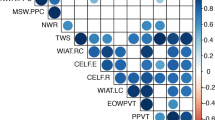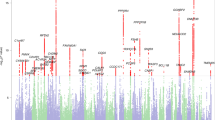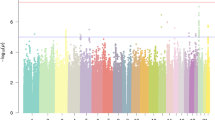Abstract
Dyslexia is a common and complex developmental disorder manifested by unexpected difficulty in learning to read. Multiple different measures are used for diagnosis, and may reflect different biological pathways related to the disorder. Impaired phonological decoding (translation of written words without meaning cues into spoken words) is thought to be a core deficit. We present a genome scan of two continuous measures of phonological decoding ability: phonemic decoding efficiency (PDE) and word attack (WA). PDE measures both accuracy and speed of phonological decoding, whereas WA measures accuracy alone. Multipoint variance component linkage analyses (VC) and Markov chain Monte-Carlo (MCMC) multipoint joint linkage and segregation analyses were performed on 108 families. A strong signal was observed on chromosome 2 for PDE using both VC (LOD=2.65) and MCMC methods (intensity ratio (IR)=32.1). The IR is an estimate of the ratio of the posterior to prior probability of linkage in MCMC analysis. The chromosome 2 signal was not seen for WA. More detailed mapping with additional markers provided statistically significant evidence for linkage of PDE to chromosome 2, with VC-LOD=3.0 and IR=59.6 at D2S1399. Parametric analyses of PDE, using a model obtained by complex segregation analysis, provided a multipoint maximum LOD=2.89. The consistency of results from three analytic approaches provides strong evidence for a locus on chromosome 2 that influences speed but not accuracy of phonological decoding.
This is a preview of subscription content, access via your institution
Access options
Subscribe to this journal
Receive 12 print issues and online access
$259.00 per year
only $21.58 per issue
Buy this article
- Purchase on Springer Link
- Instant access to full article PDF
Prices may be subject to local taxes which are calculated during checkout




Similar content being viewed by others
References
Shaywitz SE, Shaywitz BA, Fletcher JM, Escobar MD . Prevalence of reading disability in boys and girls. JAMA 1990; 264: 998–1002.
Katusic SK, Colligan RC, Barbaresi WJ, Schaid DJ, Jacobsen SJ . Incidence of reading disability in a population-based birth cohort, 1976–1982, Rochester, MN. Mayo Clin Proc 2001; 76: 1075–1077.
Berninger V . Dyslexia, the invisible, treatable disorder: the story of Einstein's Ninja Turtles. Learning Disability Quart 2000; 23: 175–195.
Berninger VW, Abbott RD, Thomson JB, Raskind WH . Language phenotype for reading and writing disability: a family approach. Sci Stud Reading 2001; 5: 59–106.
Bruck M . Word recognition skills of adults with childhood diagnoses of dyslexia. Dev Psychol 1990; 26: 439–454.
Bruck M . Persistence of dyslexics' phonological awareness deficits. Dev Psychol 1992; 5: 874–886.
Bruck M . Word recognition and component phonological processing skills of adults with childhood diagnosis of dyslexia. Dev Rev 1993; 13: 258–268.
Pennington B, Van Orden G, Smith S, Green P, Haith M . Phonological processing skills and deficits in adult dyslexics. Child Dev 1990; 61: 1753–1778.
Wilson AM, Lesaux NK . Persistence of phonological processing deficits in college students with dyslexia who have age-appropriate reading skills. J Learning Disabilities 2001; 34: 394–400.
Wagner R, Torgesen J . The nature of phonological processing and its causal role in the acquisition of reading skills. Psychol Bull 1987; 101: 192–212.
Pennington B . The Development of Psychopathology. Nature and Nurture. Guilford: New York, 2002.
Morris R, Stuebing K, Fletcher J, Shaywitz S, Lyon GR, Shakweiler D et al. Subtypes of reading disability: variability around a phonological core. J Educ Psychol 1998; 90: 347–373.
Snowling MJ . From language to reading and dyslexia. Dyslexia 2001; 7: 37–46.
Stanovich KE, Siegel LS . Phenotypic performance profile of children with reading disabilities: a regression-based test of the phonological-core variable-difference model. J Educ Psychol 1994; 86: 24–53.
Felton RH, Naylor CE, Wood FB . Neuropsychological profile of adult dyslexics. Brain Lang 1990; 39: 485–496.
Shaywitz SE, Fletcher JM, Holahan JM, Schneider AE, Marchione KE, Stuebing KK et al. Persistence of dyslexia: the Connecticut longitudinal study at adolescence. Pediatrics 1999; 104: 1351–1359.
Hatcher J, Snowling MJ, Griffiths YM . Cognitive assessment of dyslexic students in higher education. Br J Educ Psychol 2002; 72: 119–133.
Ramus F, Rosen SF, Dakin SC, Day BL, Castellote JM, White S et al. Theories of developmental dyslexia: insights from a multiple case study of dyslexic adults. Brain 2003; 126: 841–865.
Fisher SE, DeFries JC . Developmental dyslexia: genetic dissection of a complex cognitive trait. Nat Neurosci 2002; 3: 767–780.
Fagerheim T, Raeymaekers P, Tonnessen FE, Pedersen M, Tranebjaerg L, Lubs HA . A new gene (DYX3) for dyslexia is located on chromosome 2. J Med Genet 1999; 36: 664–669.
Nopola-Hemmi J, Myllyluoma B, Haltia T, Taipale M, Ollikainen V, Ahonen T et al. A dominant gene for developmental dyslexia on chromosome 3. J Med Genet 2001; 38: 658–664.
Pennington B, Gilger JW, Pauls D, Smith SA, Smith SD, DeFries JC . Evidence for a major gene transmission of developmental dyslexia. JAMA 1991; 266: 1527–1534.
Wijsman EM, Peterson D, Leutenegger A-L, Thomson JB, Goddard KAB, Hsu L et al. Segregation analysis of phenotypic components of learning disabilities, I. Nonword memory and digit span. Am J Hum Genet 2000; 67: 631–646.
Chapman N, Raskind WH, Thomson J, Berninger VW, Wijsman EM . Segregration analysis of dyslexia phenotypes 2: phonological decoding and phonological efficiency. Am J Med Genet (Neuropsychol Genet) 2003; 121B: 60–70.
Tzenova J, Kaplan BJ, Petryshen TL, Field LL . Confirmation of a dyslexia susceptibility locus on chromosome 1p34–p36 in a set of 100 Canadian families. Am J Med Genet (Neuropsychiatric Genet) 2004; 27B: 117–124.
Grigorenko EL, Wood FB, Meyer MS, Pauls JED, Hart LA, Pauls DL . Linkage studies suggest a possible locus for developmental dyslexia on chromosome 1p. Am J Med Genet 2001; 105: 120–129.
Fisher SE, Francks C, Marlow AJ, MacPhie IL, Newbury DF, Cardon LR et al. Independent genome-wide scans identify a chromosome 18 quantitative-trait locus influencing dyslexia. Nat Genet 2002; 30: 86–91.
Petryshen TL, Kaplan BJ, Hughes ML, Tzenova J, Field LL . Supportive evidence for the DYX3 dyslexia susceptibililty gene in Canadian families. J Med Genet 2002; 39: 125–126.
Kaminen N, Hannula-Jouppi K, Kestila M, Lahermo P, Muller K, Kaaranen M et al. A genome scan for developmental dyslexia confirms linkage to chromosome 2p11 and suggests a new locus on 7q32. J Med Genet 2003; 40: 340–345.
Cardon LR, Smith SD, Fulker DW, Kimberling WJ, Pennington BF, DeFries JC . Quantitative trait locus for reading disability on chromosome 6. Science 1994; 266: 276–279.
Cardon LR, Smith SD, Fulker DW, Kimberling WJ, Pennington BF, DeFries JC . Quantitative trait locus for reading disability: correction [letter]. Science 1995; 268: 1553.
Grigorenko EL, Wood FB, Meyer MS, Hart LA, Speed WC, Shuster A et al. Susceptibility loci for distinct components of developmental dyslexia on chromosomes 6 and 15. Am J Hum Genet 1997; 60: 27–39.
Grigorenko EL, Wood FB, Meyer MS, Pauls DL . Chromosome 6p influences on different dyslexia-related cognitive processes: further confirmation. Am J Hum Genet 2000; 66: 715–723.
Gayán J, Smith SD, Cherny SS, Cardon LR, Fulker DW, Brower AM et al. Quantitative-trait locus for specific language and reading deficits on chromosome 6p. Am J Hum Genet 1999; 64: 157–164.
Fisher SE, Marlow AJ, Lamb J, Maestrini E, Williams DF, Richardson AJ et al. A quantitative-trait locus on chromosome 6p influences different aspects of developmental dyslexia. Am J Hum Genet 1999; 64: 146–156.
Petryshen TL, Kaplan BJ, Fu Liu M, de French NS, Tobias R, Hughes M et al. Evidence for a susceptibility locus on chromosome 6q influencing phonological coding dyslexia. Am J Med Genet 2001; 105: 507–517.
Hsiung G-YR, Kaplan BJ, Petryshen TL, Lu S, Field LL . A dyslexia susceptibility locus (DYX7) linked to dopamine D4 receptor (DRD4) region on chromosome 11p15.5. Am J Med Genet (Neuropsychiatr Genet) 2004; 125B: 112–119.
Smith SD, Kimberling WJ, Pennington BF, Lubs HA . Specific reading disability: identification of an inherited form through linkage analysis. Science 1983; 219: 1345–1347.
Smith SD, Pennington BF, Kimberling WJ, Ing PS . Familial dyslexia: use of genetic linkage data to define subtypes. J Am Acad Child Adolesc Psychiatry 1990; 29: 204–213.
Schulte-Körne G, Grimm T, Nöthen MM, Müller-Myshok B, Cichon S, Vogt IR et al. Evidence for linkage of spelling disability to chromosome 15. Am J Hum Genet 1998; 63: 279–282.
Morris DW, Robinson L, Turic D, Duke M, Webb V, Milham C et al. Family-based association mapping provides evidence for a gene for reading disability on chromosome 15q. Hum Mol Genet 2000; 9: 843–848.
Chapman NH, Igo RP, Thomson JB, Matsushita M, Brkanac Z, Holzman T et al. Linkage analyses of four regions previously implicated in dyslexia: confirmation of a locus on chromosome 15q. Am J Med Genet (Neuropsychol Genet) 2004; 131B: 67–75.
Torgesen J, Wagner R, Reshotte C . Test of Word Reading Efficiency (TOWRE). Pro-Ed: Austin, TX, 1999.
Woodcock R . Woodcock Reading Mastery Test—Revised (WRMT-R). American Guidance Service: Circle Pines, MN, 1987.
Raskind W, Hsu L, Berninger V, Thomson J, Wijsman E . Familial aggregation of dyslexia phenotypes. Behavr Genet 2000; 30: 385–395.
Wechsler D . Wechsler Intelligence Scale for Children—Third Edition (WISC-III). The Psychological Corporation: San Antonio, TX, 1992.
Wagner R, Torgesen J, Rashotte CA . Comprehensive Test of Phonological Processing (CTOPP). Pro-Ed: Austin, TX, 1999.
Wechsler D . Wechsler Individual Achievement Test (WIAT). The Psychological Corporation: San Antonio, TX, 1992.
Wechsler Individual Achievement Test—Second Edition. Psychological Corporation: New York, NY, 2002.
Wechsler D . Wechsler Adult Intelligence Scale—Revised (WAIS-R). The Psychological Corporation: San Antonio, TX, 1981.
Geschwind DH, Boone KB, Miller BL, Swerdloff RS . Neurobehavioral phenotype of Klinefelter syndrome. Ment Retard Dev Disabil Res Rev 2000; 6: 107–116.
Boone KB, Swerdloff RS, Miller BL, Geschwind DH, Razani J, Lee Q et al. Neuropsychological profiles of adults with Klinefelter syndrome. J Int Neuropsychol Soc 2001; 7: 446–456.
Raskind WH, Conrad EU, Chansky H, Matsushita M . Loss of heterozygosity in chondrosarcomas for markers linked to hereditary multiple exostoses loci on chromosomes 8 and 11. Am J Hum Genet 1995; 56: 1132–1139.
Kong A, Gudbjartsson DF, Sainz J, Jonsdottir GM, Gudjonsson SA, Richardsson B et al. A high-resolution recombination map of the human genome. Nat Genet 2002; 31: 241–247.
Cottingham R, Idury RM, Schaffer AA . Faster sequential genetic linkage computations. Am J Hum Genet 1993; 53: 252–263.
Amos CI . Robust variance-components approach for assessing genetic linkage in pedigrees. Am J Hum Genet 1994; 54: 535–543.
Heath SC, Snow GL, Thompson EA, Tseng C, Wijsman EM . MCMC segregation and linkage analysis. Genet Epidemiol 1997; 14: 1011–1016.
Almasy L, Borecki I . Exploring genetic analysis of complex traits through the paradigm of alcohol dependence: summary of GAW11 contributions. Genet Epidemiol 1999; 17 (Suppl 1): S1–S24.
Shmulewitz D, Heath SC . Genome scans for Q1 and Q2 on general population replicates using Loki. Genet Epidemiol 2001; 21 (Suppl 1): S686–S691.
Williams J, Duggirala R, Blangero J . Statistical properties of a variance components method for quantitatitve trait linkage analysis in nuclear families and extended pedigrees. Genet Epidemiol 1997; 14: 1065–1070.
Amos C, de Andrade M . Genetic linkage methods for quantitative traits. Stat Methods Med Res 2001; 10: 3–25.
Allison D, Neale M, Zannolli R, Schork N, Amos C, Blangero J . Testing the robustness of the likelihood-ratio test in a variance-component quantitative-trait loci-mapping procedure. Am J Hum Genet 1999; 65: 531–544.
Blangero J, Williams J, Almasy L . Robust LOD scores for variance component-based linkage analysis. Genet Epidemiol 2000; 19: S8–S14.
Forrest W, Feingold E . Composite statistics for QTL mapping with moderately discordant sibling pairs. Am J Hum Genet 2000; 66: 1642–1660.
Epstein MP . Comment on ‘Ascertainment adjustment in complex diseases’. Genet Epidemiol 2002; 23: 209–213.
Glidden D, Liang K-Y . Ascertainment adjustment in complex diseases. Genet Epidemiol 2002; 23: 201–208.
Daw EW, Heath SC, Wijsman EM . Multipoint oligogenic analysis of age-at-onset data with applications to Alzheimer's disease pedigrees. Am J Hum Genet 1999; 64: 839–851.
Wijsman EM, Yu D . Joint oligogenic segregation and linkage analysis using Bayesian Markov chain Monte Carlo Methods. Mol Biotechnol 2004; 28: 205–226.
Gelman A, Carlin J, Stern H, Rubin D . Bayesian Data Analysis, 2nd edn. Chapman & Hall: New York, 2004.
Williamson JA, Amos CI . Guess LOD approach: sufficient conditions for robustness. Genet Epidemiol 1995; 12: 163–176.
Ott J . Analysis of Human Genetic Linkage, 3rd edn. Johns Hopkins University Press: Baltimore, 1999.
Clerget-Darpoux F, Bonaiti-Pellie C, Hochez J . Effects of misspecifying genetic parameters in lod score analysis. Biometrics 1986; 42: 393–399.
Greenberg D, Abreu P, Hodge S . The power to detect linkage in complex disease by means of simple LOD-score analyses. Am J Hum Genet 1998; 63: 870–879.
Jarvik G . Complex segregation analysis: uses and limitations. Am J Hum Genet 1998; 63: 942–946.
Risch N, Giuffra L . Model misspecification and multipoint linkage analysis. Hum Hered 1992; 42: 77–92.
Bonney G . Regressive logistic models for familial disease and other binary traits. Biometrics 1986; 42: 611–625.
S.A.G.E. Statistical analysis for genetic epidemiology computer program package available from the department of Epidemiology and Biostatistics. Rammelkamp Center for Education and Research. MetroHealth Campus, Case Western Reserve University: Cleveland, 1997.
Abecasis GR, Cherny SS, Cookson WO, Cardon LR . Merlin—rapid analysis of dense genetic maps using sparse gene flow trees. Nat Genet 2002; 30: 97–101.
Almasy L, Blangero J . Multipoint quantitative-trait linkage analysis in general pedigrees. Am J Hum Genet 1998; 62: 1198–1211.
Self SG, Liang K-Y . Asymptotic properties of maximum likelihood estimators and likelihood ratio tests under nonstandard conditions. J Am Stat Assoc 1987; 82: 605–610.
Heath SC . Markov Chain Monte Carlo Segregation and linkage analysis for oligogenic models. Am J Hum Genet 1997; 61: 748–760.
Wijsman EM . Joint segregation and linkage analysis using Markov Chain Monte Carlo methods. In: Camp N, Cox A (eds). Quantitative Trait Loci: Methods and Protocols, Vol 195. Humana Press: Totowa 2002, pp 139–161.
Ott J . Analysis of Human Genetic Linkage. Johns Hopkins University Press: Baltimore, 1991.
Wimmer H . The nonword reading deficit in developmental dyslexia: evidence from children learning to read German. J Exp Child Psychol 1996; 61: 80–90.
Zoccolotti P, DeLuca M, DiPace E, Judica A, Orlandi M, Spinelli D . Markers of developmental surface dyslexia in a language (Italian) with high grapheme-phoneme correspondence. App Psycholing 1999; 20: 191–216.
Leinonen S Mueller K, Leppaenen PHT, Aro M, Ahonen T, Lyytinen H . Heterogeneity in adult dyslexic readers: relating processing skills to the speed and accuracy of oral text reading. Read Writ 2001; 14: 265–296.
Landerl K . Word recognition deficits in German: more evidence from a representative sample. Dyslexia 2001; 7: 183–196.
Laasonen M, Lahti-Nuuttila P, Virsu V . Developmentally impaired processing speed decreases more than normally with age. Neuroreport 2002; 13: 1111–1113.
Berninger VW, Abbott RD, Thomson J, Wagner R, Swanson HL, Raskind W . Modeling developmental dyslexia subphenotypes in children and adults: understanding phonological core deficits within a working memory architecture, submitted.
Marlow AJ, Fisher SE, Francks C, MacPhie IL, Cherny SS, Richardson AJ et al. Use of multivariate linkage analysis for dissection of a complex cognitive trait. Am J Hum Genet 2003; 72: 561–570.
Acknowledgements
We appreciate the expert help of Department of Educational Psychology graduate students Sylvia Abbott, Allison Brooks, Ana Rueda Brown, Rebecca Brooksher, Julie Busse, Kristina Byrd, Belle Chenault, Gerry Curtin, Kate Eschen, Julie Gibson, Sarah Hellewege, Diana Hoffer, Renee Hartman, Stephanie King, Linelle Milatchov, Stacy Ogier, Tanya Prather, James Rodriguez, and Jared Taylor in administering the test battery. John Wolff provided technical help in processing all the blood and DNA samples and Hiep Nguyen provided computer support. We thank Richard Wagner and Joseph Torgesen for allowing us to use the prepublication measures of the CTOPP. We are grateful to the families for their willingness to devote the time necessary to participate in these studies. These studies were supported by grant P50 33812 from the National Institute of Child Health and Development. Some of the results of this article were obtained by use of the program SAGE, which is supported by a US Public Health Service Grant (1 P41 RR03655) from the National Center for Research Resources.
Author information
Authors and Affiliations
Corresponding author
Additional information
Electronic database information
URLs for data and programs in this article are as follows:
Loki version 2.4.5: http://www.stat.washington.edu/thompson/Genepi/Loki.shtml
Marshfield maps: http://research.marshfieldclinic.org/genetics
SOLAR 2.1: http://www.sfbr.org/sfbr/public/software/solar/
S.A.G.E.: http://www.statsol.ie/sage/sage.htm
Rights and permissions
About this article
Cite this article
Raskind, W., Igo, R., Chapman, N. et al. A genome scan in multigenerational families with dyslexia: Identification of a novel locus on chromosome 2q that contributes to phonological decoding efficiency. Mol Psychiatry 10, 699–711 (2005). https://doi.org/10.1038/sj.mp.4001657
Received:
Revised:
Accepted:
Published:
Issue Date:
DOI: https://doi.org/10.1038/sj.mp.4001657
Keywords
This article is cited by
-
Differential diagnosis of dysgraphia, dyslexia, and OWL LD: behavioral and neuroimaging evidence
Reading and Writing (2015)
-
Teaching children with dyslexia to spell in a reading-writers’ workshop
Annals of Dyslexia (2013)
-
Do dyslexics misread a ROWS for a ROSE?
Reading and Writing (2013)
-
A theoretical molecular network for dyslexia: integrating available genetic findings
Molecular Psychiatry (2011)
-
Genome Scan for Spelling Deficits: Effects of Verbal IQ on Models of Transmission and Trait Gene Localization
Behavior Genetics (2011)



